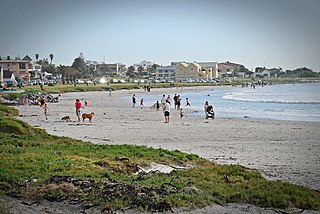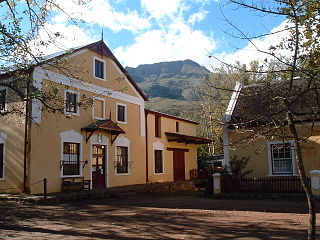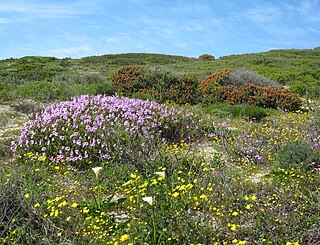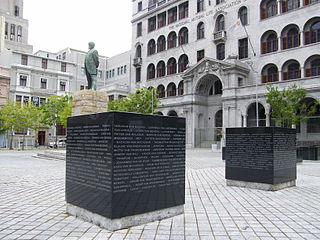
The Cape Colony, also known as the Cape of Good Hope, was a British colony in present-day South Africa named after the Cape of Good Hope. It existed from 1795 to 1802, and again from 1806 to 1910, when it united with three other colonies to form the Union of South Africa, then became the Cape Province, which existed even after 1961, when South Africa had become a republic, albeit, temporarily outside the Commonwealth of Nations (1961–94).

Daniël Hartman Craven was a South African rugby union player (1931–1938), national coach, national and international rugby administrator, academic, and author. Popularly known as Danie, Doc, or Mr Rugby, Craven's appointment from 1949 to 1956 as coach of the Springboks signalled "one of the most successful spells in South African rugby history" during which the national team won 74% of their matches. While as a player Craven is mostly remembered as one of rugby's greatest dive-passing scrumhalves ever, he had also on occasion been selected to play for the Springboks as a centre, fly-half, No.8, and full-back. As the longest-serving President of the South African Rugby Board (1956–93) and chairman of the International Rugby Board, Craven became one of the best-known and most controversial rugby administrators. In 1969, Craven sparked outrage among anti-apartheid activists when he allegedly said, "There will be a black springbok over my dead body". Craven denied saying this and in his later career promoted coloured training facilities.

Francis William Reitz, Jr. was a South African lawyer, politician, statesman, publicist, and poet who was a member of parliament of the Cape Colony, Chief Justice and fifth State President of the Orange Free State, State Secretary of the South African Republic at the time of the Second Boer War, and the first president of the Senate of the Union of South Africa.

Woodstock is one of the earliest suburbs of Cape Town, South Africa, between the docks of Table Bay and the lower slopes of Devil's Peak, about 1 kilometre (0.6 mi) east of the city centre of Cape Town. Woodstock is served by Woodstock and Esplanade railway stations, and has the postal code 7925 for street addresses and 7915 for post office box deliveries.

Bloubergstrand is a seaside suburb of the City of Cape Town, South Africa, along the shores of Table Bay, 15 kilometres (9.3 mi) due north of the city centre of Cape Town. The name Bloubergstrand literally means "blue mountain beach" in Afrikaans, and is derived from Blaauwberg, a nearby hill. Bloubergstrand is mainly a residential area, and attracts large numbers of visitors especially kitesurf enthusiasts. The beach at Bloubergstrand is a popular location for a classic view of Table Mountain across the bay and is one of the world's top kitesurf destinations. Robben Island is located 6.9 kilometres (4.3 mi) west of the coast of Bloubergstrand.

Uys is the surname of a family that played a significant role in South African history during the nineteenth century and made distinguished contributions to South African culture, politics and sports during the course of the twentieth.

Melkbosstrand is a coastal town located on the South West Coast of South Africa, 30 km north of Cape Town. It forms part of the City of Cape Town Metropolitan Municipality, the municipality governing Cape Town and its greater metropolitan area.
The area known today as Cape Town has no written history before it was first mentioned by Portuguese explorer Bartholomeu Dias in 1488. The German anthropologist Theophilus Hahn recorded that the original name of the area was '||Hui !Gais' – a toponym in the indigenous Khoi language meaning "where clouds gather."

The Battle of Blaauwberg, also known as the Battle of Cape Town, fought near Cape Town on Wednesday 8 January 1806, was a small but significant military engagement during the War of the Third Coalition, one of the Napoleonic Wars. After a British victory, peace was made under the Treaty Tree in Woodstock establishing British control over the Dutch Cape Colony. The Cape later became a permanent part of the British Empire following the Congress of Vienna that marked the end of the Napoleonic Wars in 1814. By establishing permanent British rule over the Cape Colony the battle would have many ramifications for the southern Africa region during the nineteenth and twentieth centuries. A bi-centennial commemoration was held in January 2006.

Genadendal is a town in the Western Cape province of South Africa, built on the site of the oldest mission station in the country. It was originally known as Baviaanskloof, but was renamed Genadendal in 1806. Genadendal was the place of the first Teachers' Training College in South Africa, founded in 1838.
Johannes du Plessis Scholtz was a South African philologist, art historian, and art collector.

Sideroxylon inerme is a southern and eastern African coastal tree, with dense foliage, black berries and small, foetid, greenish flowers. The tree's generic name means "Iron-wood" in Greek, referring to its very hard timber.

The Dutch Cape Colony was a Dutch United East India Company (VOC) colony in Southern Africa, centered on the Cape of Good Hope, from where it derived its name. The original colony and the successive states that the colony was incorporated into occupied much of modern South Africa. Between 1652 and 1691, it was a Commandment, and between 1691 and 1795, a Governorate of the VOC. Jan van Riebeeck established the colony as a re-supply and layover port for vessels of the VOC trading with Asia. The Cape came under VOC rule from 1652 to 1795 and from 1803 to 1806 was ruled by the Batavian Republic. Much to the dismay of the shareholders of the VOC, who focused primarily on making profits from the Asian trade, the colony rapidly expanded into a settler colony in the years after its founding.

Cape Flats Dune Strandveld is an endangered vegetation type. This is a unique type of Cape Strandveld that is endemic to the coastal areas around Cape Town, including the Cape Flats.

A tameletjie is a homemade toffee confection which features prominently within the Afrikaner and Malay cultures of South Africa. The sweet is made from sugar and water which has been boiled until caramelized and then rested to cool to form a hard sweet. There are many variations to the sweet attained by adding almonds, pine nuts or coconut to the recipe.
S. V. Petersen was an Afrikaans-language South African poet and author, educator and founding principal of the Athlone High School, Silvertown Athlone, Cape Town. He was the first person of colour whose poetry and prose were published in South Africa.

Coornhoop is a historic 17th century farmhouse. It is located at 2 Dixton Road in Observatory, Cape Town. Currently, it houses the Centre for Conflict Resolution.

The following outline is provided as an overview of and topical guide to Cape Town:

Church Square in Cape Town, South Africa, lies in front of the Groote Kerk at the intersection of Parliament and Spin Streets. It currently features a park.

The Korps Pandoeren, or Corps Pandoeren, was a light infantry unit raised in the Cape Colony from the Khoekhoe and mixed population to aid in the colony's defence. The unite was raised in 1793 following France's declaration of war with the Netherlands at the outbreak of the French Revolutionary Wars. The unit was disbanded by the British following the capture of the Cape Colony in 1806. The unit saw action during the Invasion of the Cape Colony in 1795 and the Battle of Blaauwberg in 1806. The corps was noted for its skill in fighting unconventional actions.



















